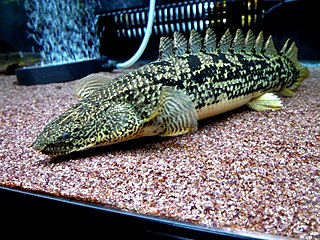
Bichirs and the reedfish comprise Polypteridae, a family of archaic ray-finned fishes and the only family in the order Polypteriformes.

Cirrhitidae, the hawkfishes, are a family of marine perciform ray-finned fishes found in tropical seas and which are associated with coral reefs.

Polypterus senegalus, the Senegal bichir, gray bichir or Cuvier's bichir, and sometimes called the "dinosaur eel", "dinosaur bichir", or "dragon fish" is in the pet trade due to its lungfish-like appearance, which was described as more primitive and prehistoric than other modern fishes. It is a prototypical species of fish in the genus Polypterus, meaning most of its features are held across the genus. It is commonly kept in captivity by hobbyists. They are native from Africa where they are the most widespread species of the genus.

Scatophagidae, the scats are a small family of ray-finned fishes in the order Perciformes. They are found in the Indo-Pacific region but one species has been introduced elsewhere.

Peristediidae, the armored sea robins or armoured gurnards, is a family of ray-finned fishes belonging to the suborder Platycephaloidei in the order Scorpaeniformes. They are found in the deep water in the tropical and warm temperate of the world's oceans.

The Guinean bichir is a ray-finned fish from rivers and other freshwater habitats in Western Africa, ranging from Guinea-Bissau to Nigeria. It reaches a maximum length of 72 cm (28 in), is greenish-brown to black in color, and has large, dark spots and blotches on its sides. On mature specimens, the bottom jaw may protrude very slightly. It is similar to some other bichirs with which it can be confused.

The barred bichir, armoured bichir, bandback bichir, or banded bichir is an elongated fish found in the Congo River, specifically in the upper and middle portions. This species is one of the more commonly available in commercial pet stores.
Max Fernand Leon Poll was a Belgian ichthyologist who specialised in the Cichlidae. In the years 1946 and 1947 he organised an expedition to Lake Tanganyika.

The saddled bichir, Polypterus endlicheri endlicheri, is a prototypical subspecies of the Polypterus genus, meaning most of its features are held across the genus.

Polypterus congicus, the Congo bichir, is a species of bichir with a maximum recorded size of 970 millimetres (38 in). The colour also varies from yellowish brown to grey, darker in the top, paler in the ventral area. It has a pattern of around 8 irregular vertical bands along the flanks of the fish, that do not extend completely onto the ventral surface. The lower jaw is prominent, much like Polypterus endlicheri. The male has a wider and thicker anal fin. These fish are commonly sold as pets.
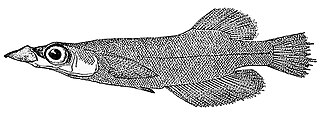
Adrianichthys is a genus of ricefishes. The genus is endemic to Lake Poso in Sulawesi, Indonesia. All four species are considered seriously threatened and two of these, A. kruyti and A. roseni, have not been recorded for decades, leading to fears that they already are extinct. Adrianichthys are larger than the Oryzias ricefish, reaching lengths of 8.5–17.1 cm (3.3–6.7 in) depending on the exact species involved. The name of this genus is a compound ending in the Greek ichthys for "fish" with the first part honouring the linguist and missionary Nicolaus Adriani (1865-1926), who collected specimens around Lake Poso.

Fodiator is a genus of flying fishes. It is the only genus in the subfamily Fodiatorinae.

Polypterus palmas, also called the shortfin or marbled bichir, is a fish in the family Polypteridae found in freshwater environments throughout West Africa.
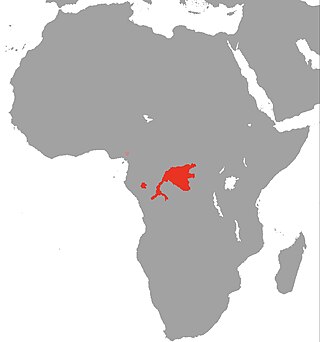
The West African bichir or retropinnis bichir, is a freshwater fish in the family Polypteridae, is found in the central Congo River basin and Ogooué River in Africa. It is a long, slender fish that grows to a maximum length of about 34 cm (13 in).

Polypterus weeksii, the mottled bichir, is a fish in the family Polypteridae found in the central basin of the Congo River. It grows to about 54 cm in head-to-tail length.

The congoli, also known as the freshwater flathead, marble fish, marbled flathead, sand trout, sanding, sandy, sandy whiting or tupong. is a species of marine ray-finned fish and it is the only species of fish in the monotypic family Pseudaphritidae and the genus Pseudaphritis. It was initially classified as a member of the family Bovichtidae.
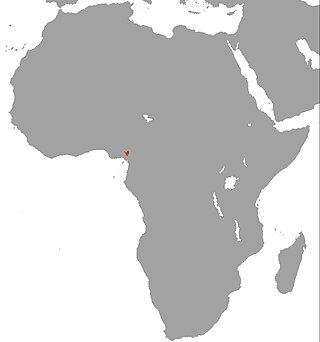
Polypterus teugelsi is a species of carnivorous, nocturnal bichir that lives in the Cross River drainage basin in the country of Cameroon. P. teugelsi was described in 2004 by Ralf Britz.

Polypterus mokelembembe is a species of the fish genus Polypterus, found in the central basin of the Congo River. It was once considered a morph of the closely related Polypterus retropinnis, but was given species status in 2006 with a description that reclassified both fishes. Because of the recency of the species' description and the fact that P. mokelembembe is the paralectotype of P. retropinnis, they are often mistaken for one another in the aquarium trade.
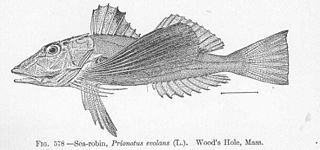
Prionotinae is a subfamily of demersal, marine ray-finned fishes, part of the family Triglidae. The fishes in this subfamily are called sea robins and are found in the Western Atlantic and Eastern Pacific Oceans, the other two Triglid subfamilies are called gurnards.

Triglinae is a subfamily of demersal, marine ray-finned fishes, part of the family Triglidae, the gurnards and searobins. These gurnards are found in all the tropical and temperate oceans of the world except for the Western Atlantic Ocean.






















